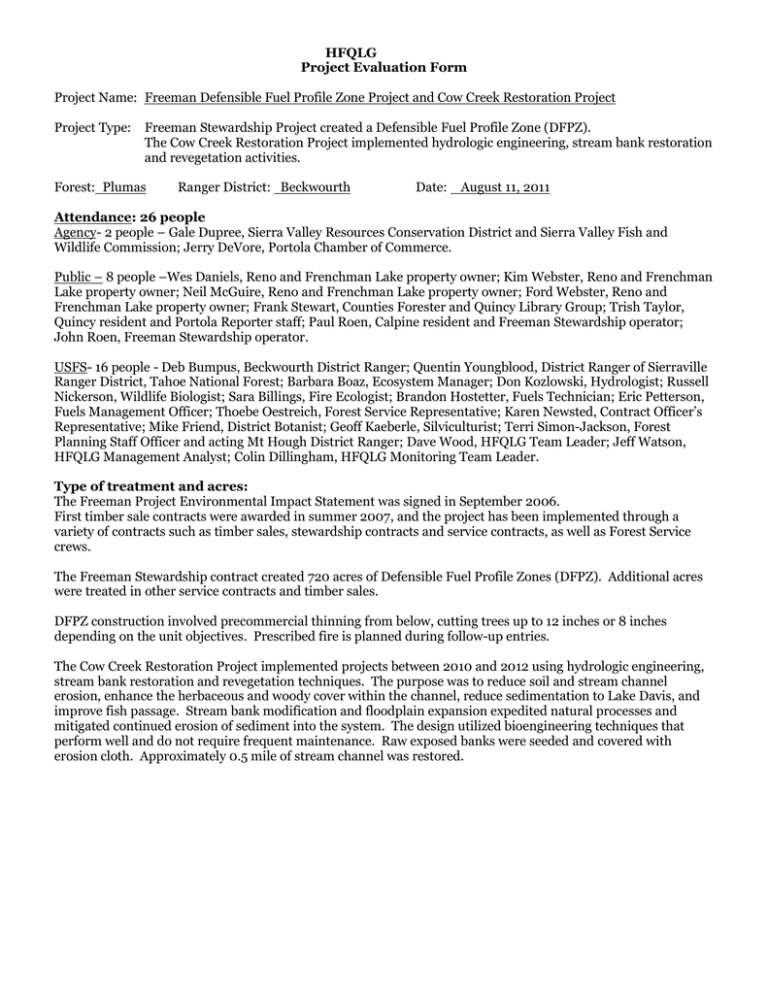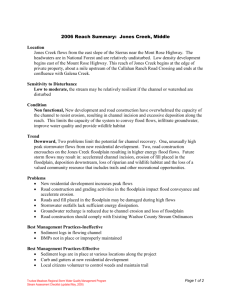HFQLG Project Evaluation Form
advertisement

HFQLG Project Evaluation Form Project Name: Freeman Defensible Fuel Profile Zone Project and Cow Creek Restoration Project Project Type: Freeman Stewardship Project created a Defensible Fuel Profile Zone (DFPZ). The Cow Creek Restoration Project implemented hydrologic engineering, stream bank restoration and revegetation activities. Forest: Plumas Ranger District: Beckwourth Date: August 11, 2011 Attendance: 26 people Agency- 2 people – Gale Dupree, Sierra Valley Resources Conservation District and Sierra Valley Fish and Wildlife Commission; Jerry DeVore, Portola Chamber of Commerce. Public – 8 people –Wes Daniels, Reno and Frenchman Lake property owner; Kim Webster, Reno and Frenchman Lake property owner; Neil McGuire, Reno and Frenchman Lake property owner; Ford Webster, Reno and Frenchman Lake property owner; Frank Stewart, Counties Forester and Quincy Library Group; Trish Taylor, Quincy resident and Portola Reporter staff; Paul Roen, Calpine resident and Freeman Stewardship operator; John Roen, Freeman Stewardship operator. USFS- 16 people - Deb Bumpus, Beckwourth District Ranger; Quentin Youngblood, District Ranger of Sierraville Ranger District, Tahoe National Forest; Barbara Boaz, Ecosystem Manager; Don Kozlowski, Hydrologist; Russell Nickerson, Wildlife Biologist; Sara Billings, Fire Ecologist; Brandon Hostetter, Fuels Technician; Eric Petterson, Fuels Management Officer; Thoebe Oestreich, Forest Service Representative; Karen Newsted, Contract Officer’s Representative; Mike Friend, District Botanist; Geoff Kaeberle, Silviculturist; Terri Simon-Jackson, Forest Planning Staff Officer and acting Mt Hough District Ranger; Dave Wood, HFQLG Team Leader; Jeff Watson, HFQLG Management Analyst; Colin Dillingham, HFQLG Monitoring Team Leader. Type of treatment and acres: The Freeman Project Environmental Impact Statement was signed in September 2006. First timber sale contracts were awarded in summer 2007, and the project has been implemented through a variety of contracts such as timber sales, stewardship contracts and service contracts, as well as Forest Service crews. The Freeman Stewardship contract created 720 acres of Defensible Fuel Profile Zones (DFPZ). Additional acres were treated in other service contracts and timber sales. DFPZ construction involved precommercial thinning from below, cutting trees up to 12 inches or 8 inches depending on the unit objectives. Prescribed fire is planned during follow-up entries. The Cow Creek Restoration Project implemented projects between 2010 and 2012 using hydrologic engineering, stream bank restoration and revegetation techniques. The purpose was to reduce soil and stream channel erosion, enhance the herbaceous and woody cover within the channel, reduce sedimentation to Lake Davis, and improve fish passage. Stream bank modification and floodplain expansion expedited natural processes and mitigated continued erosion of sediment into the system. The design utilized bioengineering techniques that perform well and do not require frequent maintenance. Raw exposed banks were seeded and covered with erosion cloth. Approximately 0.5 mile of stream channel was restored. Attribute Objective Fuels, Freeman Stewardship Project DFPZ, surface fuels Create a safe and effective DFPZ, remove surface fuels HFQLG Appendix J Yes Fuels DFPZ, ladder fuels Create a safe and effective DFPZ, eliminate ladder fuels HFQLG Appendix J Yes Silviculture Tree Growth EIS, Silviculture Prescription Yes Resource Area Smoke Soils, Freeman Stewardship Project Smoke Management Increase tree growth through management Prevent contributing to exceedence of particulate matter standards in Portola Community Source of Objective Air Quality Control Board Objectives Met? Yes Soil Cover Prevent excessive erosion by maintaining organic soil cover Plumas LRMP Yes Hydrology, Cow Creek Stream Channel Stop head cutting in stream areas. Cow Creek NEPA Yes Hydrology, Cow Creek Erosion Stop Stream Channel Erosion Cow Creek NEPA Yes Comments Chainsaw thinned and grapple pile and hand pile burned stands looked excellent. Surface fuels reduced to desired conditions Chainsaw thinned and grapple pile and hand pile burned stands looked excellent. Ladder fuels removed. Removed brush and thinned trees to accelerate growth Careful cooperation with Air Quality Control board prevented most complaints. “Nonattainment” avoided. Grapple pile operation maintained high soil cover. Follow-up burn prescriptions plan to retain portion of soil duff and litter layer. Filled scour pools to repair meadow hydrology Steep stream banks laid back to create wider flood plain and stop bank and gully erosion Discussions: Freeman Stewardship Unit 146 – Neil McGuire, landowner near Frenchman Lake, asks why on private land they are required to burn piles within 1 year of pile creation, but Forest Service created burn piles are on the landscape for years. He specifically mentioned some large piles in the Crystal Adams area. District Ranger Deb Bumpus explained that the contractor for Crystal Adams defaulted on that contract, so that was the specific reason those piles remained for a long time. It was also explained that the Forest Service is under different rules than private landowners. Freeman Stewardship Unit 146 – Fuels Technician Brandon Hostetter and Fire Ecologist Sara Billings explain that they create approximately the same number of piles each year as they burn. Grapple piles, such as the one on the right created in this Freeman Stewardship contract, would be burned this fall or winter. The district can only burn approximately 10 acres per day before they start to risk exceeding the allowable smoke emissions to the community of Portola. Freeman Stewardship Unit 146 – Karen Newsted, Contract Officer’s Representative, explains the prescription to thin the forest and create a Defensible Fuel Profile Zone in the Lake Davis area. The prescription thinned the forest to approximately 20 ft X 20 ft spacing and removed brush over 1 inch in diameter which will allow for the trees to put on approximately 4 inches of growth in diameter every 10 years. District Silviculturist Geoff Kaeberle explained that the treatment doubled the growth rate of the retained trees. Freeman Stewardship Unit 146 – Sierra Valley Resources Conservation District representative Gale Dupree asked why the Forest Service doesn’t prune the trees to reduce the flammability of the forest. It was explained that although the lower dead limbs do pose a minor risk, it is the live limbs that are a more serious risk. The cost of pruning the lower limbs is too expensive to justify the minor increase in fuel treatment effectiveness. Around homes, especially when pruning live limbs, it is a far more useful and justifiable technique. Creation of Defensible Fuel Profile Zone (DFPZ) network – Colin Dillingham, monitoring coordinator, and Counties QLG forester Frank Stewart explained the purpose of the system of fuel reduction projects on the network. When asked if the network works when tested by wildfire, Frank explained that the HFQLG monitoring program has completed an assessment of 20 wildfires that burned into DFPZs and they have been shown to be effective. Frank suggested people review the report (see link below) http://www.fs.fed.us/r5/hfqlg/monitoring/resource_reports/fire_and_smoke/dfpz_effectiveness/HFQ LG%20treatment%20effectiveness%20report.pdf Freeman Stewardship Unit 122 – Fuels ecologist Sara Billings explained the completed chainsaw thinning, hand piling and pile burning treatment that had been completed in this area. Forest Service firefighting crews treated this 10-acre unit to create a portion of the shaded fuel break network. The piles were burned in 2009 (one burned pile is located under the man with the white hat) and the completed treatment is considered a safe place to fight fires from the ground. There is a cost-benefit to using ground crews instead of helicopters and air tankers. Cow Creek Stream Restoration –Hydrologist Don Kozlowski gives the group an overview of the historical and pre-restoration stream and meadow conditions. He explained how the delivery of sediment from channel erosion into Lake Davis affected the trout fishery. He explained that the purpose of the project was primarily to stop erosion, repair eroded channels, restore vegetation on the stream banks, and improve fish passage. The group stands on a rock grade control structure, which doubled as an equipment stream crossing location. Cow Creek Stream Restoration –Raw exposed banks were seeded and covered with erosion cloth to prevent sediment delivery from un-vegetated banks caused by construction activity. Cow Creek Stream Restoration – willow cuttings from Freeman Creek were planted in newly constructed floodplain and lower contoured bank areas to provide stability and flow resistance when they mature. Rehabilitation through revegetation is critical to soil protection, habitat enhancement, and reduction of overland flow velocities. Cow Creek Stream Restoration – the project filled deep scour pools within the overflow channel. Sections of the overflow stream channel were well incised into the meadow, resulting in gully erosion and meadow decline. Individual headcuts had formed in the channel and were treated to stop upmeadow migration. Cow Creek Stream Restoration – The treatment was initially successful. Despite the higher and longer than average flows that occurred in spring of 2011, channel erosion was minimal in the overflow channel and only a couple of re-contoured banks exhibited any erosion. Willows have begun to sprout and fine sediment is depositing on the newly formed floodplains, reducing sediment delivery to Lake Davis and helping to shape the evolving channel. This process will accelerate as more vegetation establishes on the new floodplains. Successes and Shortcomings: A safe and effective Defensible Fuel Profile Zone was constructed to protect the National Forest and nearby communities The Cow Creek restoration project repaired head cuts and gullies in the stream system. Follow up actions: Under burn treatments are planned to complete surface fuel treatments in Freeman DFPZ units. Notes prepared by: HFQLG Monitoring Team Leader: /s/ Reviewed by District Ranger: Colin Dillingham __/s/ Deb Bumpus Date: August 11, 2011 Date: August 15, 2011


